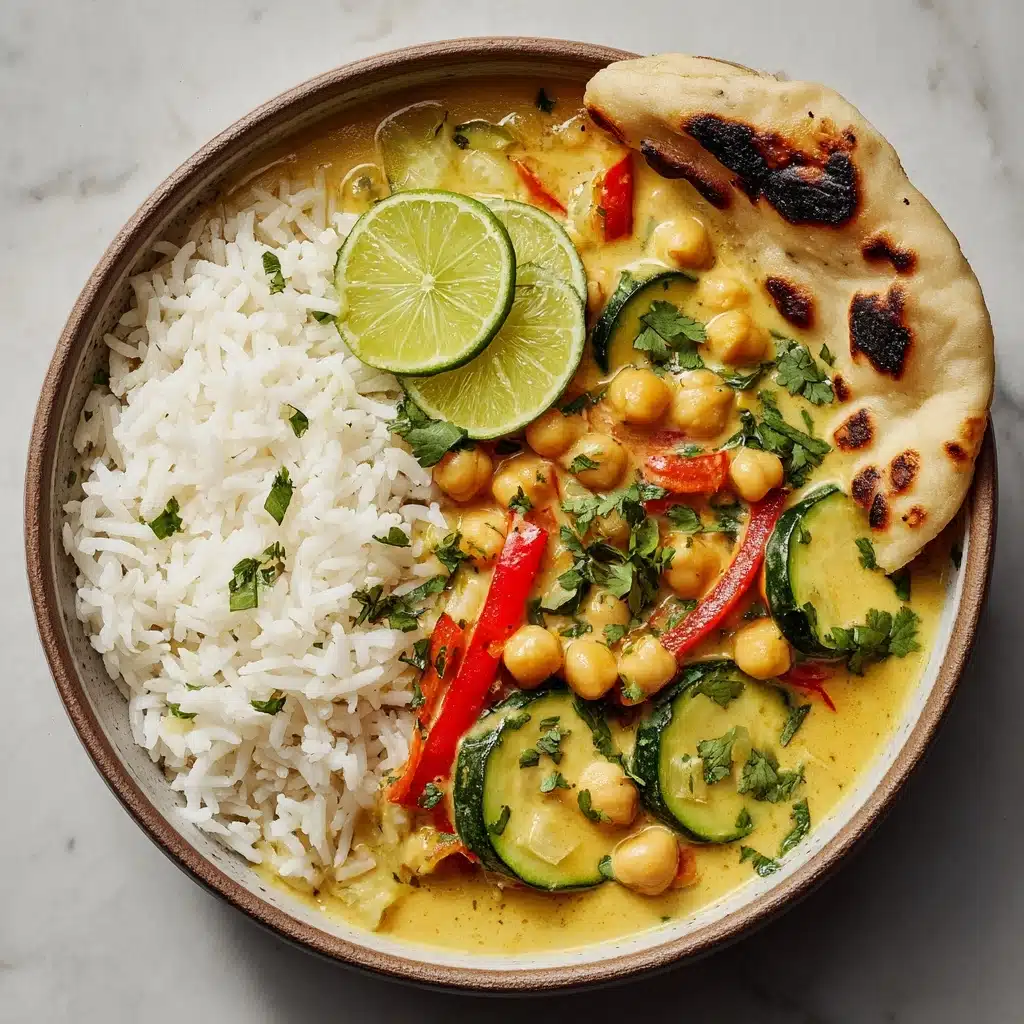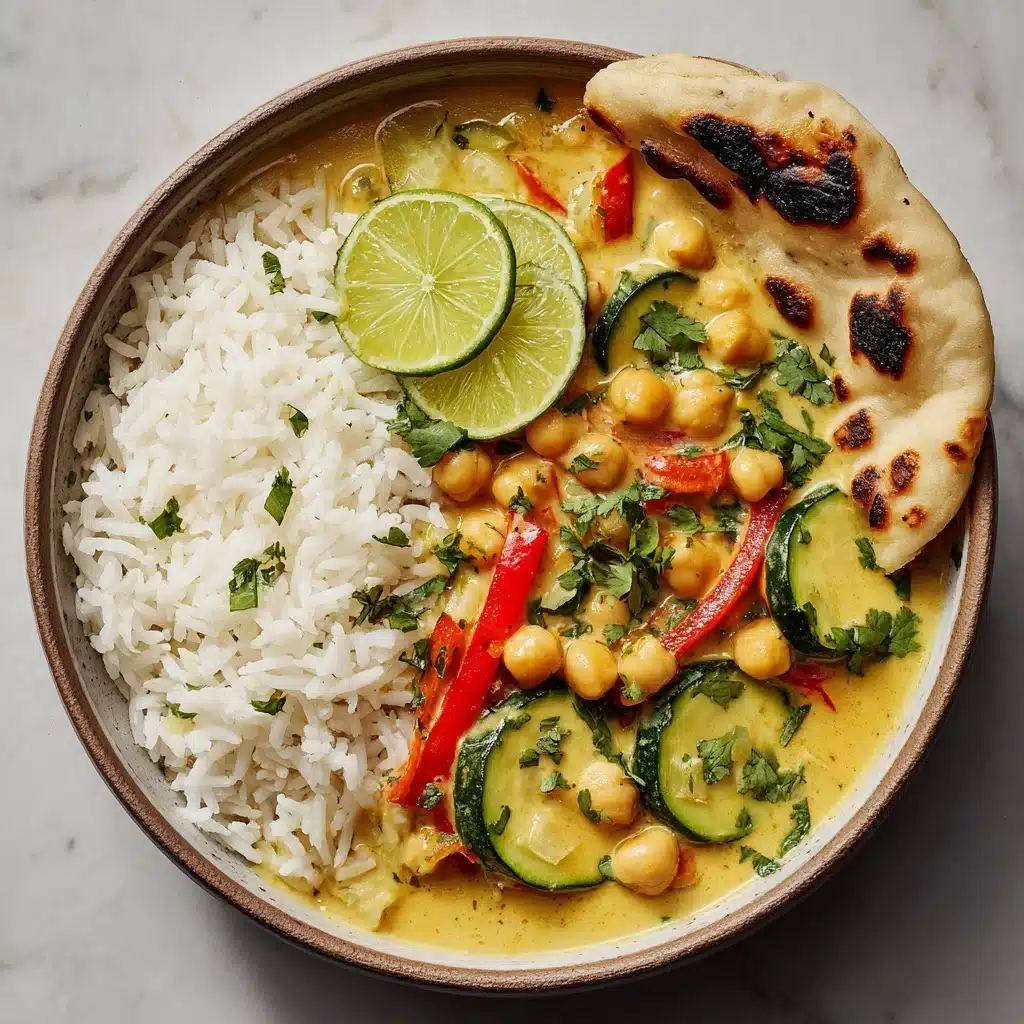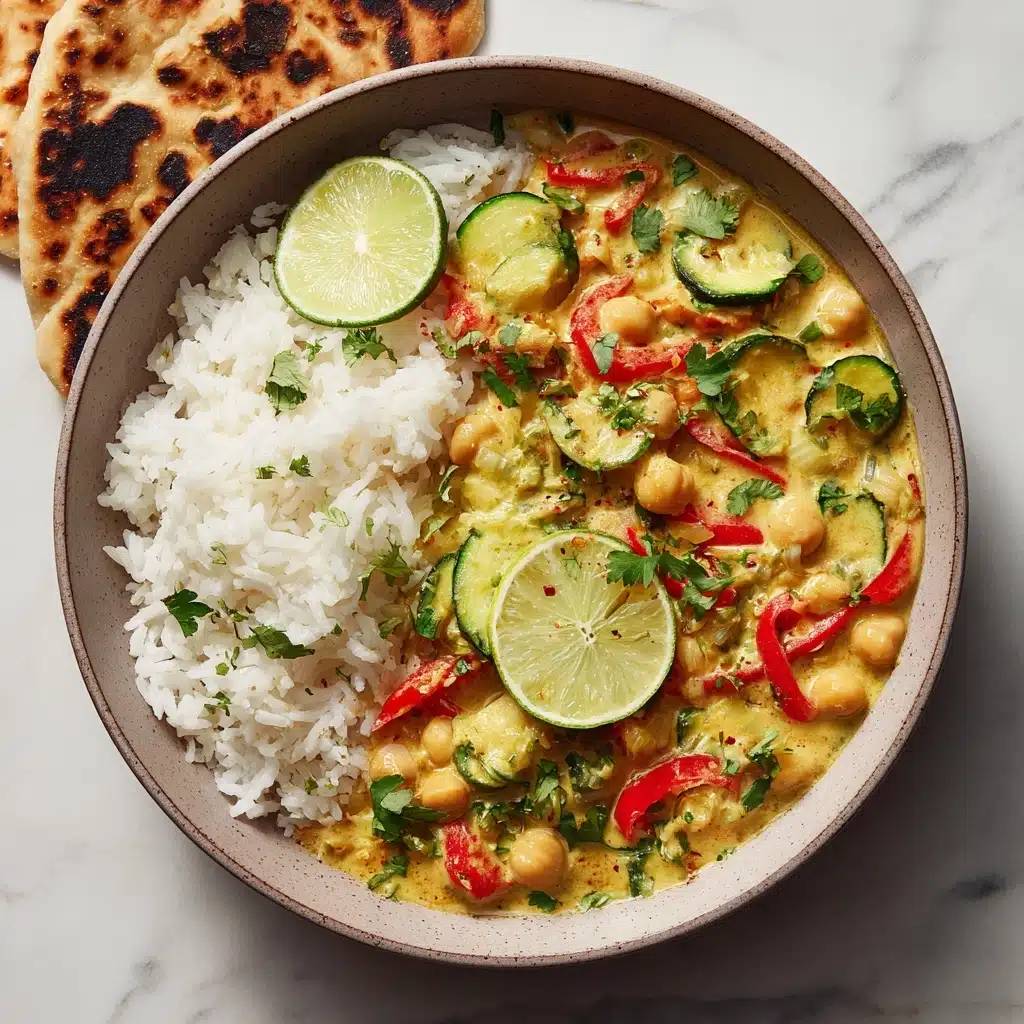Get ready to fall head-over-heels in love with this Coconut Curry, a vibrant, luscious dish that is bursting with aromatic spices, creamy coconut milk, and an irresistible medley of colorful veggies. If you’ve ever longed for comfort in a bowl that comes together in under thirty minutes but tastes like it simmered all day, this one is your new go-to! Whether you’re vegan, gluten-free, or just a fan of seriously delicious food, this recipe combines familiar pantry staples with a couple of special upgrades to deliver big, bold flavor every time.
Ingredients You’ll Need
I adore this dish because the ingredient list is short and straightforward, yet each component offers something unique—creamy texture, rich umami, sunshine-bright color, and of course, that signature Coconut Curry aroma that wafts through the house as it simmers. Here’s what brings it all together:
- Coconut oil: Lays down a subtle, tropical base and helps bloom the spices for extra flavor depth.
- Onion: Adds natural sweetness and a gentle backbone that supports every other ingredient.
- Garlic: Delivers essential robust, savory notes—don’t be shy here!
- Fresh ginger: Gives a subtle warmth and zing that truly distinguishes homemade Coconut Curry from anything store-bought.
- Red curry paste: Packs complex, punchy flavor; adjust the amount to your preferred heat level.
- Ground turmeric: Turns everything golden and brings a hint of earthy, peppery flavor.
- Ground cumin: Adds gentle smokiness and rounds out the spices beautifully.
- Full-fat coconut milk: The secret to a silky, rich sauce—you want the full-fat version for best results.
- Vegetable broth: Loosens up the curry and introduces deep, savory undertones.
- Carrots: Offer sweetness and vibrant orange color; they’re perfectly tender by the end.
- Red bell pepper: Brings crunch and a fresh burst of sweetness to contrast the creamy sauce.
- Zucchini: Soaks up all those gorgeous curry flavors while maintaining a gentle bite.
- Chickpeas: Deliver hearty plant-based protein and really soak up the flavors of the curry.
- Soy sauce or tamari: Adds umami depth and saltiness; use tamari if you need this Coconut Curry gluten-free.
- Lime juice: The finishing touch—bright acidity to balance the coconut’s richness.
- Salt and pepper: Adjust these at the end to make every ingredient sing.
- Chopped cilantro: For a pop of color and fresh, herby lift right before serving.
- Cooked jasmine rice: There’s nothing better to sop up that luscious curry sauce!
How to Make Coconut Curry
Step 1: Sweat the Aromatics
Start by heating the coconut oil in a large skillet or pot over medium heat. Once the oil shimmers, toss in the chopped onion and let it slowly soften for about 3 to 4 minutes, stirring occasionally. The aroma at this stage hints at the magic to come! Now, stir in your garlic and ginger, and sauté for just another minute until your kitchen is filled with that heavenly fragrance—be careful not to let anything brown.
Step 2: Build the Spice Base
To fully unlock the flavors of your Coconut Curry, sprinkle in the red curry paste, turmeric, and cumin. Stir well to coat the onion, garlic, and ginger, allowing the spices to toast and intensify their flavors. This step is where your curry develops its rich backbone and enticing color. Use a spatula to scrape up any bits sticking to the pan and mix until everything is perfectly combined.
Step 3: Pour in Creaminess and Broth
Gently pour in the full-fat coconut milk and vegetable broth, stirring as you go. You’ll see that velvety coconut milk swirl together with the roasted spices, creating a gorgeous golden hue. Use your spoon to break up any clumps of curry paste so everything is smooth and unified—this is the creamy curry base of your dreams!
Step 4: Add the Veggies and Chickpeas
Toss in the carrots, bell pepper, zucchini, and chickpeas. Give everything a good stir so each piece is tucked into that decadent sauce. Increase the heat just until it reaches a gentle simmer, then reduce the heat and let the Coconut Curry bubble softly for 15 to 20 minutes. The veggies will become delightfully tender and the flavors meld together in every spoonful.
Step 5: Final Seasoning and Finish
When the vegetables are fork-tender and your kitchen smells like a cozy Thai restaurant, stir in the soy sauce (or tamari) and finish with a squeeze of lime juice. Taste and season with salt and pepper. The lime brings brightness and makes those deep curry flavors pop. Serve your Coconut Curry piping hot over fluffy jasmine rice, and don’t forget a shower of chopped cilantro for freshness.
How to Serve Coconut Curry

Garnishes
Fresh cilantro is a classic, but don’t stop there if you’re feeling creative! Thinly sliced green onions, toasted coconut flakes, or an extra wedge of lime all bring even more vibrance and flavor. If you’re after heat, scatter over some fresh red chili for that spicy finish or even a few crunchy peanuts for contrast.
Side Dishes
Coconut Curry is dreamy all on its own, but pairing it with perfectly cooked jasmine or basmati rice is an easy win—both varieties soak up the sauce beautifully. If you want to round out the meal, consider a crisp cucumber salad or warm naan bread to scoop up every last drop. Even a side of quick-pickled veggies will add a nice tang and crunch.
Creative Ways to Present
For a show-stopping dinner, serve this Coconut Curry in shallow bowls, letting the colors of the veggies shine. Hosting friends? Present the curry family-style in a big, colorful pot at the center of the table with lots of topping bowls so everyone can customize. Or, for meal prep, portion it into glass jars layered with rice at the bottom, then curry, and fresh herbs on top—a feast for the eyes even before lunch breaks out!
Make Ahead and Storage
Storing Leftovers
Let your Coconut Curry cool to room temperature, then scoop it into airtight containers and stash in the fridge. It keeps beautifully for up to four days, and I honestly think the flavors get even better as it sits—the veggies soak up even more of that incredible sauce.
Freezing
Yes, you can freeze Coconut Curry! Simply transfer the cooled curry into freezer-safe containers, leaving a little space at the top for expansion. It will keep well in the freezer for up to three months. When ready to eat, just thaw in the fridge overnight.
Reheating
To reheat, transfer the Coconut Curry to a pot over low heat and stir occasionally until hot. If it’s thickened a bit in the fridge, a splash of water or coconut milk will loosen it right up. For microwave reheating, cover loosely to prevent splatters and stir halfway through to distribute the heat evenly.
FAQs
Can I add different vegetables to this Coconut Curry?
Absolutely! This recipe is endlessly flexible. Swap in sweet potato, baby spinach, green beans, or snap peas—just adjust the cooking time for heartier veggies and add delicate greens at the end so they wilt beautifully.
Is this Coconut Curry spicy?
It’s got a gentle kick thanks to the red curry paste, but you control the heat. For more intensity, add a chopped chili, a pinch of red pepper flakes, or extra curry paste. Want it mild? Use a bit less paste and skip any added chilies.
How can I add more protein?
Chickpeas already provide a nice base of plant protein, but if you want more, add cubes of tofu, seared shrimp, or cooked chicken. Just stir them in alongside the vegetables and let them soak up all that coconutty, spiced flavor.
Can I make this Coconut Curry ahead of time?
Definitely! This curry is perfect for meal prep, as the flavors only deepen overnight. Store in individual portions or one big container in the fridge, and simply reheat when you’re ready to serve.
Is this recipe gluten-free?
It sure can be! Just use tamari instead of soy sauce and double-check your curry paste label to guarantee it’s gluten-free. With these swaps, you’ll have a totally gluten-free Coconut Curry that everyone can enjoy.
Final Thoughts
If you’re ready to add some sunshine and spice to your weeknight lineup, give this Coconut Curry a try. I promise, once you taste just how easy and delicious it is, you’ll be craving it again and again—friends and family will, too!
Print
Coconut Curry Recipe
- Prep Time: 10 minutes
- Cook Time: 20 minutes
- Total Time: 30 minutes
- Yield: 4 servings
- Category: Main Course
- Method: Stovetop
- Cuisine: Thai
- Diet: Vegan
Description
This flavorful Coconut Curry is a Thai-inspired dish packed with vegetables, chickpeas, and aromatic spices in a creamy coconut broth. It’s a perfect balance of sweet, spicy, and savory flavors that pairs beautifully with jasmine rice.
Ingredients
Main Curry:
- 1 tablespoon coconut oil
- 1 medium onion, chopped
- 3 garlic cloves, minced
- 1 tablespoon fresh ginger, grated
- 2 tablespoons red curry paste
- 1 teaspoon ground turmeric
- 1 teaspoon ground cumin
- 1 can (13.5 oz) full-fat coconut milk
- 1 cup vegetable broth
- 2 medium carrots, sliced
- 1 red bell pepper, sliced
- 1 zucchini, chopped
- 1 cup chickpeas, cooked or canned, drained and rinsed
- 1 tablespoon soy sauce or tamari
- juice of 1 lime
- salt and pepper to taste
For Serving:
- Chopped cilantro for garnish
- Cooked jasmine rice
Instructions
- Heat the coconut oil: In a large skillet or pot over medium heat.
- Add spices: Red curry paste, turmeric, and cumin, stir well.
- Add vegetables: Carrots, bell pepper, zucchini, chickpeas. Simmer for 15–20 minutes.
Add onion, sauté until translucent. Stir in garlic and ginger until fragrant.
Pour in coconut milk and vegetable broth, stir until smooth.
Stir in soy sauce, lime juice, salt, and pepper. Serve over jasmine rice, garnished with cilantro.
Notes
- You can add tofu, chicken, or shrimp for extra protein.
- For a spicier curry, add a chopped chili or more curry paste.









